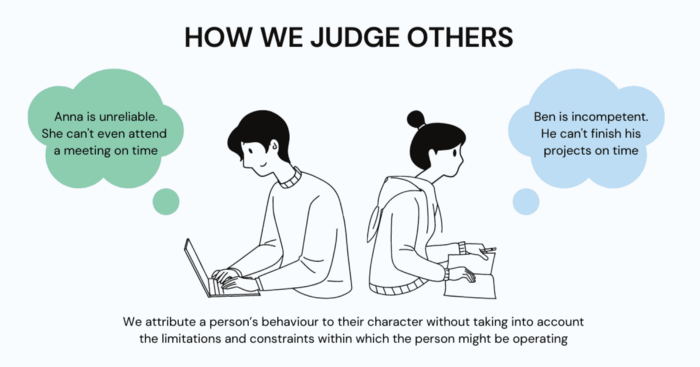The Actor–observer asymmetry refers to our tendency to attribute external causes to our behavior and to attribute internal causes to the behavior of others. Thus, to explain our action, we will name more elements concerning the situation (difficulty of the task, chance, etc.) than personal elements (effort made, personality, etc.). Conversely, and in accordance with the fundamental attribution error, when we observe another person’s behavior, we instead explain said behavior by characteristics specific to the person observed, not to the situation. This difference in thinking can cause problems in getting along with others. It’s not just about people one-on-one but also between different groups. Like, if someone in our group does something wrong, we blame outside stuff.
This mix-up in thinking can cause misunderstandings and mess up how we relate to each other individually and between groups. Understanding this helps us see things clearer and work better together.
How can Actor–observer asymmetry be used in messaging?
Actor–observer asymmetry is a cognitive bias that refers to the tendency to attribute our own behavior to external factors, while attributing the behavior of others to internal factors. In the context of messaging, understanding and leveraging this bias can be valuable. Here are a few ways it can be used:
- Empathy: Recognizing the bias can help message senders empathize with recipients. By considering that the observer (recipient) may attribute their own behavior differently, the sender can craft messages that take this into account, fostering understanding and reducing misinterpretation.
- Perspective-taking: By acknowledging the bias, messaging can be designed to encourage perspective-taking. This can involve encouraging recipients to consider the external factors that might have influenced the sender’s behavior, leading to more open-mindedness and less judgment.
- Conflict resolution: The bias can be addressed during conflicts to facilitate resolution. Helping both parties understand that external factors might influence their actions can promote a more balanced and less accusatory discussion, leading to better conflict management.
- Relationship building: Awareness of bias can also help build stronger relationships through messaging. By acknowledging that others might see our behavior differently, we can actively engage in more reflective and understanding conversations, fostering trust and rapport.
Leveraging the actor-observer bias in messaging should be done with sensitivity and genuine intent to understand others rather than manipulating or deceiving.
How can Actor–observer asymmetry influence decision making?
Actor–observer asymmetry can provide insights into customer decisions in various industries. Here are a few examples:
Retail: In the retail industry, Actor-Observer Bias can help explain customer behavior when making purchasing decisions. Customers may attribute their purchase choices to external factors like sales, discounts, or product availability. On the other hand, they might attribute the choices of other customers to personal preferences or characteristics. This bias can influence marketing strategies, such as emphasizing situational factors (limited-time offers, scarcity) to drive customer decisions.
Hospitality: In the hospitality industry, Actor-Observer Bias can shed light on how customers perceive their own experiences compared to others’. Customers may attribute their positive experiences to the quality of service or amenities provided by the establishment. However, they may attribute negative experiences of other customers to their personal preferences or attitudes. Understanding this bias can help businesses address customer concerns, manage expectations, and improve overall customer satisfaction.
Financial services: Actor-Observer Bias can impact customer decisions in financial services. This bias can influence how financial institutions design and market their products and services, taking into account customers’ perceptions of their own financial capabilities.
Technology: In the technology industry, Actor-Observer Bias can explain how customers perceive their adoption of new technologies versus others. Customers may attribute their adoption to the benefits and convenience of the technology. In contrast, they may attribute the lack of adoption by others to resistance to change or lack of technological competence. Businesses can leverage this bias by highlighting the positive aspects of their technology to encourage customer adoption.
These are just a few examples, but Actor-Observer Bias can be observed across various industries and provide insights into understanding customer decisions. By recognizing and considering this bias, businesses can tailor their strategies and communication to meet customer needs and expectations better.
Give some examples of Actor–observer asymmetry:
Traffic Situations: When we’re late due to traffic, we often attribute it to the situation (“There was so much traffic!”). However, when someone else is late, we might attribute it to their lack of punctuality (“They’re always running late!”).
Work Performance: If we make a mistake at work, we might blame it on being overloaded or having a tough day (“I had too much on my plate!”). But if a colleague messes up, we might attribute it to their incompetence (“They just can’t handle the job!”).
Sports and Competitions: When we win a game, we might credit our skills and effort (“I played really well today!”). However, if the opponent wins, we might attribute it to luck or favorable circumstances (“They got lucky!”).
Relationships: If we forget an anniversary or special occasion, we might blame it on being too busy or forgetful (“I’ve had a lot on my mind!”). But if our partner forgets, we might attribute it to them being thoughtless or uncaring (“They just don’t care about these things!”).
In each of these situations, there’s a difference in how we explain our own behavior versus how we explain others’ behavior. We often attribute our actions to external factors, while attributing others’ actions to their internal traits or characteristics.
Summary – Actor-observer asymmetry highlights how we tend to attribute our own actions to external factors while attributing others’ behavior to their internal traits. This bias affects how we judge, make decisions, and interact with others. Recognizing this bias can lead to fairer judgments, better decision-making, and improved collaboration by considering external factors influencing behaviors.
Newristics, a company specializing in optimizing messaging, understands the nuances of human behavior and biases like actor-observer asymmetry. By leveraging insights into cognitive biases, they tailor messaging strategies to resonate effectively with audiences. Understanding these biases is crucial in crafting messages that account for how people perceive and attribute behaviors, ultimately enhancing communication effectiveness and achieving desired outcomes.




